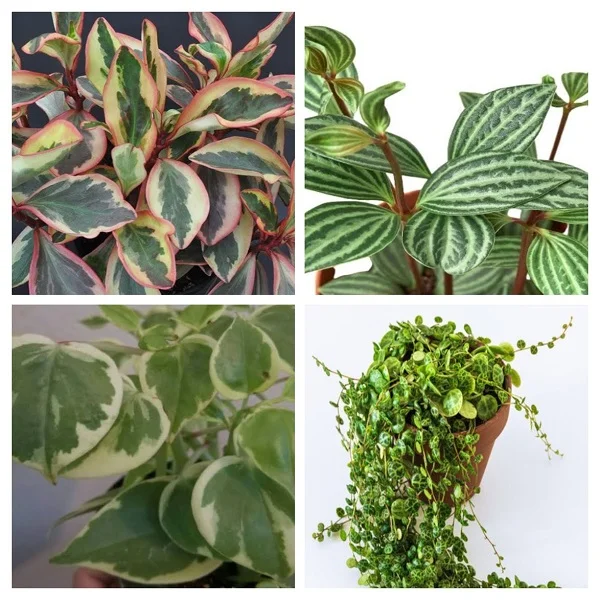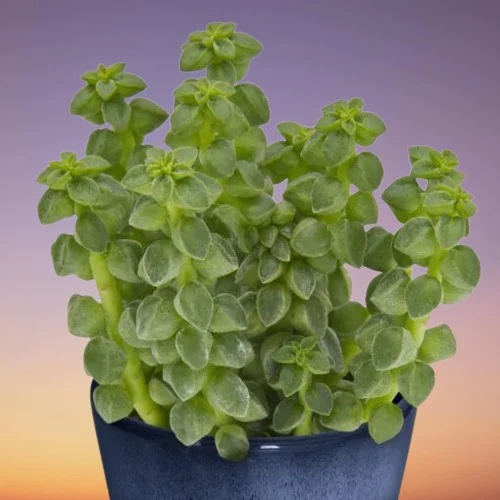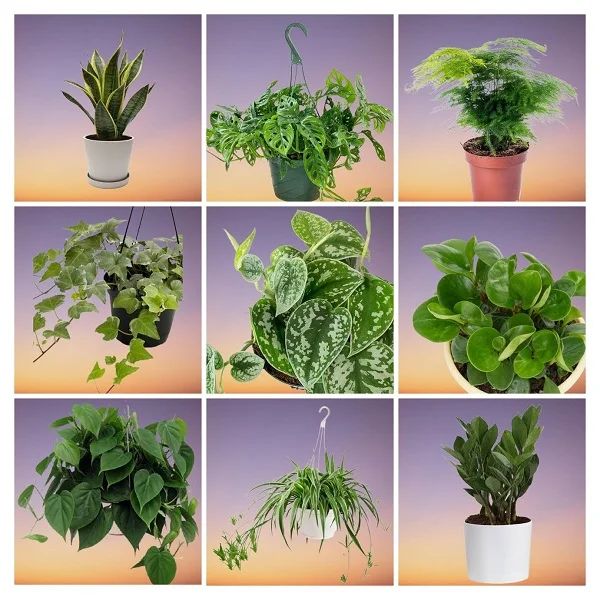Variegated Cupid Peperomia (Peperomia scandens 'Variegata') Care Indoors
Some links in this post may be affiliate links
Variegated Cupid Peperomia flourishes in medium to bright indirect light, average warmth, humid conditions and moderately moist, rich, well-drained soil coupled with monthly feeding in the growing season.
Variegated Cupid Peperomia also called False Philodendron is one of the popular Peperomia varieties and bears fleshy, heart-shaped leaves and pink, semi-succulent stems.
False Philodendron is a trailing plant whose stems can spread to a width of 5 feet. The leaves are green with cream-colored, golden, yellow, or off-white markings.
Like the spectacular Piggyback Plant (Tolmiea menziesii), Variegated Cupid Peperomia is among the best plants for a hanging basket.
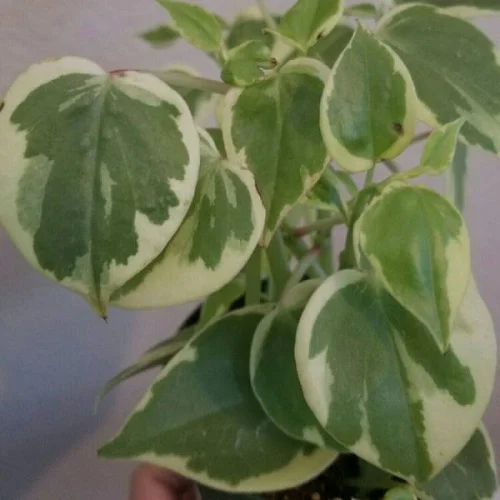
Botanical name: Peperomia scandens 'Variegata'
Synonym: Peperomia nitida 'Variegata'
Family: Piperaceae
Common names: Variegated Cupid Peperomia, False Philodendron
Origin
Peperomia scandens 'Variegata' is native to South and Central America and Mexico rainforests, where it grows on top of trees.
Flower
Variegated Cupid Peperomia bears tiny, green flowers which are borne on a spike inflorescence that resemble rat tails.
Is Variegated Cupid Peperomia toxic?
Variegated Cupid Peperomia like other Peperomia Plants is non-toxic to humans and pets. They are among the pet-safe plants ideal for growing indoors.
Peperomia scandens 'Variegata' Care Indoors
Variegated Cupid Peperomia requires medium to bright indirect light (filtered light), average warmth of 15-260C, humidity of 55-65% and moderately moist, fertile, all purpose potting soil coupled with monthly feeding during the growing season.
Peperomia scandens 'Variegata' requires regular pruning to keep it neat, minimize pest and disease infestations as well as rejuvenate growth. Repotting is only needed when the plant becomes extremely pot-bound. Keep reading for more details on these growing conditions and how to achieve them.
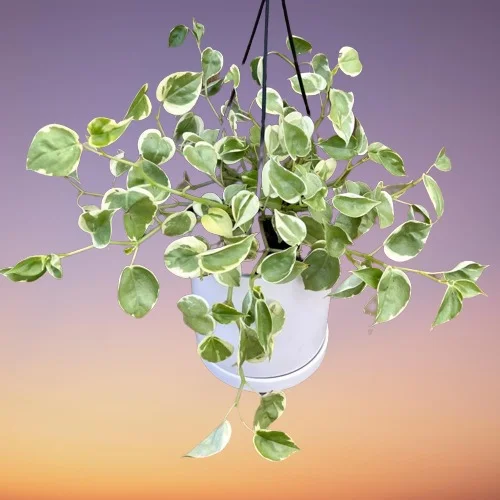
Watering
Water Variegated Cupid Peperomia liberally during the growing season and allow the top 2-3 inches of soil to dry out between waterings. Lessen watering in the cold season to keep the soil barely moist as growth is minimal at this time.
Confirm that the pot has a drainage hole to prevent the soil from getting soggy as it can lead in root-rot and death of the plant. Learn more on how to water houseplants the correct way.
Light Requirements
Variegated Cupid Peperomia grows best in bright indirect light. Keep it away from direct sunshine to prevent scorching of the leaves.
Too little light will result in a leggy plant and loss of leaf variegation therefore, ensure it receives adequate light. Where the natural light is not sufficient, you may grow the plant under a grow light. Check out these full spectrum grow lights on Amazon.
Rotate the pot regularly to ensure that the plant receives light on all sides for even growth as well as prevent legginess.
Temperature and Humidity
Variegated Cupid Peperomia requires an average warmth within the range of 15-260C. Room temperatures that are comfortable for you are ideal for the plant. Keep it away from cold drafts as they can cause leaf drop.
Peperomia scandens 'Variegata' thrives in a humidity of 55-65%. To raise humidity, set pot on a wet pebble tray or use a cool mist humidifier.It can also be grown in a closed terrarium where a high humidity can be maintained. Read more on how to elevate humidity for houseplants.
Occasionally clean the leaves by damp-wiping with a soft cloth to get rid of dust and also discourage pest and disease infestations. Ensure that there is good air circulation to minimize fungal diseases.
On account of its affinity for a warm humid environment, Variegated Cupid Peperomia is one of the best plants for a closed terrarium as these conditions can be maintained inside a terrarium.
Potting Mix
The best potting mix for Peperomia scandens 'Variegata' should be rich in organic matter and free-draining to prevent it from getting soggy while providing the required nutrients. All purpose potting mixes are ideal for this plant.
Fertilizer
Feed Variegated Cupid Peperomia with a balanced, liquid fertilizer every 4 weeks during the growing period to promote lush growth. Do not feed in the cold season as growth is reduced and feeding at this time can lead to fertilizer burn.
Repotting
Repot Variegated Cupid Peperomia during the growing season only when the plant has become pot-bound. Use a pot one size larger than the current one.
Ensure that the pot has a drainage hole to prevent the soil from getting soggy as it can lead to root-rot. Check out these ceramic pots with drainage holes and saucer on Amazon.
Pruning
Pruning Variegated Cupid Peperomia is easy as it involves regular removal of dead foliage to maintain the plant neat and reduce pests and diseases.
Regularly pinch off the growing tips to encourage a bushy, compact growth. As the plant ages, it becomes straggly therefore, cutback the stems during the growing season to rejuvenate growth.
Propagation
Peperomia scandens 'Variegata' can be propagated in 3 ways; from leaf cuttings, from stem cuttings or by plant division.
Learn how to propagate Variegated Cupid Peperomia (Peperomia scandens 'Variegata' propagation)
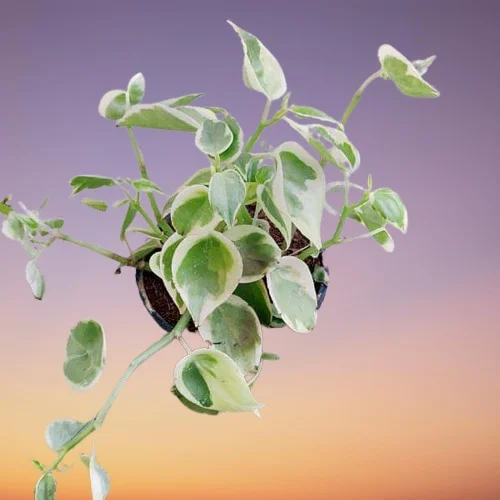
Peperomia scandens 'Variegata' Problems
Variegated Cupid Peperomia problems are brown leaf tips, dropping leaves, drooping leaves, shrivelled leaves, wilting, leggy growth, diseases and pests among others. Keep reading for more on these problems and how to fix them.
Dropping leaves
Dropping leaves (leaf fall) in Variegated Cupid Peperomia is caused by many and varied reasons like overwatering, insufficient lighting, overfeeding among others.
Check out these 12 reasons why Peperomia is dropping leaves with remedies
Drooping leaves
Variegated Cupid Peperomia leaves may droop due to many and varied reasons. One possible reason is exposure to direct sunlight. Thoroughly water the plant immediately and it should recover. Move it to a more shadier spot or instal a light curtain to filter direct sunlight from reaching the leaves.
The second possible reason for drooping leaves in Variegated Cupid Peperomia is overwatering which results in soggy soil. To avoid getting soggy soil, ensure that the pot has a drainage hole and that the soil is loose and free-draining. Reduce watering the plant during the cold season to maintain the soil barely moist as growth is minimal at this time.
The third possible reason for drooping leaves in Variegated Cupid Peperomia is underwatering which implies that there is too little moisture in the soil. As such, there is no water in the soil for the plant to take up to the leaves and other parts.
Immediately water the plant thoroughly and it should perk up. Thereafter, water the plant liberally during the growing season and allow the soil to dry out between waterings.
Related: 14 reasons why Peperomia leaves are drooping and how to fix them
Wilted, discolored leaves
Soggy soil for your Variegated Cupid Peperomia is the cause of wilted and discolored leaves and corky swellings under the leaves. This is an indication of root-rot. Isolate the affected plant and treat it appropriately for the disease. To avoid getting soggy soil, ensure that the pot has a drainage hole and the soil is free-drainage.
Diseases
Variegated Cupid Peperomia is prone to leaf spot disease. Isolate the affected plant and treat it for the disease.
Pests
Variegated Cupid Peperomia is prone to scale insects, whiteflies, mealy bugs and spider mites. Isolate the affected plant to prevent spread to other plants and treat it for the pests. Learn how to identify and control houseplants pests.
Leggy stems
Leggy stems in your Variegated Cupid Peperomia are due to too low light. This is an attempt by the plant to reach the light source. Cutback the stems to rejuvenate growth and move the plant to a brighter spot where it will receive bright indirect light or instal a grow light if the natural light is not adequate. Check out this guide on understanding light for houseplants.
Brown leaf tips and edges
Brown leaf tips and edges in Variegated Cupid Peperomia are due to sudden drop in temperature from cold drafts. Remove all the damaged leaves to keep the plant neat and tidy. Protect the plant from cold drafts from windy doors, drafty windows, air conditioners and maintain an average warmth of 15-260C. Check out this guide on understanding temperature for houseplants.
Brown, shrivelled leaves
The cause of brown and shrivelled leaves in Variegated Cupid Peperomia is too dry air. This plant requires a humidity of 55-65% to thrive. To raise humidity, set the pot on a wet pebble tray or use a cool mist humidifier. You may also grow the plant in a well-lit bathroom or in a closed terrarium.
Dry, shrivelled leaves
Excess soluble salts in the soil from the water or excess feeding will cause dry shrivelled leaves in Variegated Cupid Peperomia. Once in a while flush out the salts from the soil by running a stream of water through the soil until it comes out through the drainage holes and repeat the process several times.
You liked it? Share on social media.
Related Content
Amazon Associates Disclosure
Homeplantsguide.com is a participant in the Amazon Services LLC Associates Program, an affiliate advertising program designed to provide a means for sites to earn advertising fees by advertising and linking to amazon.com.



